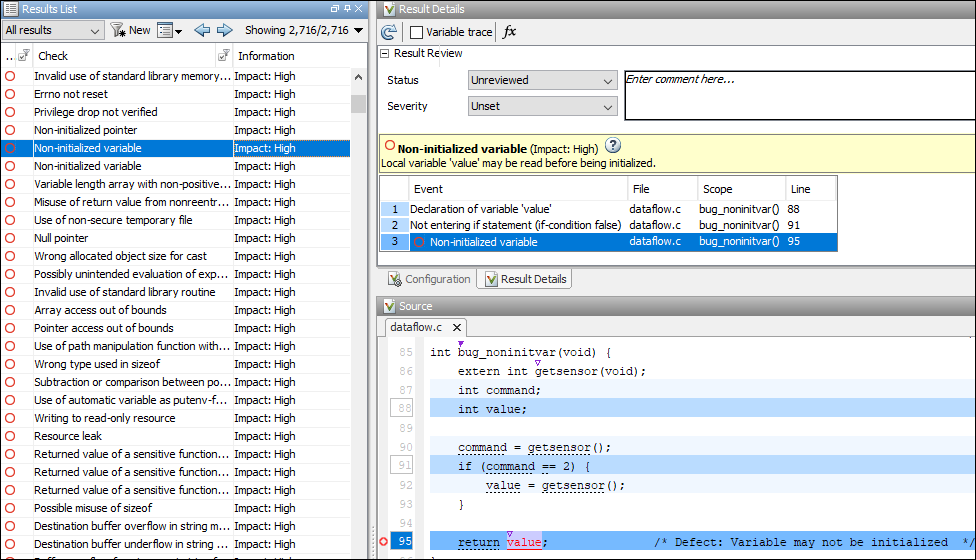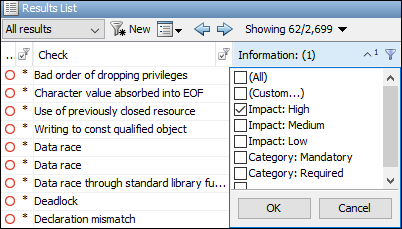在 Polyspace 用户界面中审查 Polyspace Bug Finder 结果
Polyspace® Bug Finder™ 可检查 C/C++ 代码中是否存在缺陷、编码违规和安全漏洞。运行分析后,您可以在 Polyspace 用户界面中打开结果并进行审查。
本主题说明如何在 Polyspace 用户界面中审查一些 Bug Finder 结果。桌面端 Polyspace Bug Finder 和 Polyspace Code Prover™ 产品提供了 Polyspace 用户界面。
如果您在 IDE 中使用 Polyspace as You Code 运行单文件分析,则可以直接在 IDE 中审查结果。请参阅在 IDE 中审查 Polyspace as You Code 结果。
如果您使用 Polyspace Server 产品运行分析并将结果上传到 Polyspace Access™,则可以在 Web 浏览器中审查结果。请参阅在 Web 浏览器中审查 Polyspace Bug Finder 结果。
示例文件
要遵循本教程中的步骤,请使用在桌面端运行 Polyspace Bug Finder中的步骤运行 Polyspace。
或者,在 Polyspace 用户界面中,使用帮助 > 示例 > Bug_Finder_Example.psprj 打开示例结果。如果您在上传示例结果后进行了一些更改,要加载最新副本,请选择帮助 > 示例 > 还原默认示例。
解释结果
审查每个 Polyspace 结果。查找问题的根本原因。
请从结果列表窗格中的结果列表开始。
如果结果列表窗格覆盖了整个窗口,请选择窗口 > 重置布局 > 结果审查。
如果没有看到结果的扁平列表,而是看到分组后的结果,请从
 列表中选择 无。
列表中选择 无。
要按字母顺序对结果进行排序,请点击检查列标题。选择未初始化的变量结果之一。

在源窗格中查看源代码,并在结果详细信息窗格中查看有关结果的更多信息。
结果详细信息窗格还会高亮显示导致该结果的事件序列。例如,对于未初始化的变量结果,您会看到以下事件:
已声明变量
value。已跳过
value已被初始化的if语句。已读取变量
value。
您还可以看到这些事件在源代码中以蓝色高亮显示。有时,这些事件在源代码中可能相距很远。点击结果详细信息窗格中的某个事件将导航到源代码中的对应位置。
其他信息
请参阅:
通过 Bug 修复或注释来处理结果
在了解某个 Polyspace 检查结果的根本原因后,您可以修复代码。或者,为 Polyspace 结果添加注释,以便日后修复代码或者对结果进行申述。可以使用注释来跟踪审查进度。
在源窗格中,右键点击变量 value。选择打开编辑器。代码将在文本编辑器中打开。修复问题。例如,您可以在声明期间初始化 value。
int value = -1;
另外,如果您不希望立即修复缺陷,请为结果指定待调查状态。还可以添加注释以进一步进行解释。

如果您指定未计划任何操作状态,则同一工程上的后续运行中便不会再出现该结果。
其他信息
请参阅:
管理结果
打开 Bug Finder 分析的结果时,您会看到一个包含缺陷、编码违规或其他结果的扁平列表。为了便于审查,您可以缩小列表范围,或者按文件或结果类型对结果进行分组。
例如,您可以:
仅审查影响程度大的缺陷。
要按影响程度对缺陷进行排序,请点击信息列标题。另外,您还可以过滤掉是缺陷但影响程度不高的结果。要开始过滤,请点击列标题上的
 图标。
图标。
仅审查自上次分析以来出现的新结果。
在结果列表窗格工具栏上,点击新增按钮。
审查特定文件或函数中的结果。
在结果列表窗格工具栏上,从
 列表中选择文件。
列表中选择文件。
其他信息
请参阅Filter and Group Results in Polyspace Desktop User Interface。